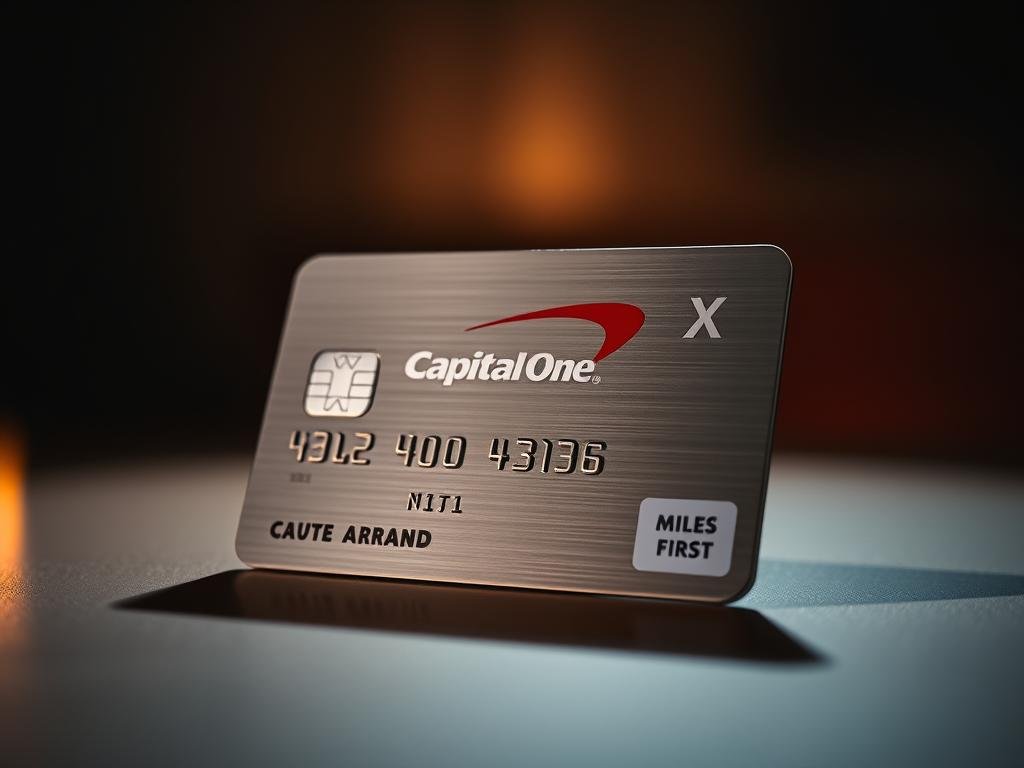You can access big travel value without juggling complex rewards. This rewards credit card blends a straightforward earning rate with premium trip perks. The welcome bonus and steady miles make it easy to see cash-like value for travel.
The card charges an annual fee but includes recurring credits that help offset costs. You earn 2x miles on every purchase and boosted rates on hotels, rental cars and flights booked through the issuer’s portal. Lounge access and statement credits add clear benefits for frequent flyers.
In short, this credit card suits travelers who want simple redemptions and flexible rewards. Read full sections ahead to learn how to take advantage of the welcome bonus, travel credit, anniversary miles, and airport lounge access.
Key Takeaways
- You earn steady miles on all purchases plus higher rates in the travel portal.
- The welcome bonus converts to meaningful travel value in the first months.
- Recurring credits and the anniversary bonus can offset the annual fee.
- Lounge access and travel protections boost the card’s practical benefits.
- Use this guide to read full details on earning, redeeming, and comparisons.
Editor’s quick take: Is Venture X worth the $395 annual fee right now?
The real question: can the $395 annual fee deliver clear value for your trips this year? If you redeem the $300 Capital One Travel credit and use the 10,000 anniversary miles, the fee is largely offset.
Who should consider it based on your travel and redemption habits
If you book hotels, rental cars, or flights through the issuer’s portal, you’ll see the biggest gains. Portal bookings earn elevated rates and keep redemptions simple at roughly 1 cent per mile.
- Worth it: You use the $300 portal credit and value the 10,000 anniversary miles.
- Best fit: Frequent flyers who want lounge access and 5x flights or 10x on hotels/rental cars in the portal.
- Maybe skip it: Rare travelers or anyone who won’t use the portal credit; the fee is harder to justify.
- Point optimizers: Can beat 1 cent per mile by transferring to partners for premium cabins.
Bottom line: The rewards credit profile and recurring credits make the fee reasonable for regular travelers who use the portal. If you don’t, another lower-fee option may suit you better.
Key numbers at a glance: rewards, fees, and bonus structure
Start with the key figures so you can judge value quickly and plan your first months. These headline metrics show what you gain at signup and how daily purchases stack up.
Welcome bonus and first months spending requirement
Bonus: Earn 75,000 miles after $4,000 in purchases in the first 3 months. At a baseline rate of 1 cent per mile, that equals about $750 in travel value.
Plan big-ticket buys into those first months so you hit the requirement without overspending.
Rewards rates on purchases inside and outside Capital One Travel
The card earns 2x miles on all purchases, keeping everyday use simple.
Book via Capital One Travel and you get portal boosts: 10x on hotels and rental cars and 5x on flights. That quickly accelerates accumulation when the trip fits your schedule and budget.
Annual fee, rates, and fees you should watch
The annual fee is $395, but recurring value helps. A $300 portal credit and a 10,000-mile anniversary bonus (about $100) offset much of the cost.
Redeem at a baseline of 1 cent per mile via the travel portal or travel statement credits for eligible charges within 90 days. Transfers to partners can exceed that value for premium flights.
- Redemption baseline: 1 cent per mile in the portal.
- Everyday earning: 2x on all purchases.
- Watch: APR and other rates and fees vary by profile; use for travel redemptions to preserve value.
How you actually earn: everyday 2X miles plus portal multipliers
You’ll collect miles every time you pay, with extra multipliers when you book travel through the issuer’s portal. This blend keeps daily earning simple while giving a clear path to faster accumulation for trips.
2X on all purchases vs category cards and cash rewards cards
Every purchase earns 2X, so the card works as a reliable default when no category bonus applies. Compared to flat 2% cash cards, your baseline value is roughly the same when you redeem at 1 cent per mile.
If a dining or groceries card offers higher rates, keep that as a supplemental option. For simplicity, use this rewards credit for miscellaneous spend and recurring bills.
10X on hotels and rental cars, 5X on flights via Capital One Travel
Book in the travel portal to capture powerful multipliers: 10X on hotels and rental cars and 5X on flights. These boosts add miles fast when your itinerary and price match portal listings.
- Use the portal for major trip bookings to accelerate returns.
- Cross-check portal prices with direct rates so the net benefit is real.
- Keep a secondary rewards credit card for category wins that outpace 2X.
Redeeming miles: travel statement credits, portal bookings, and transfers
You have straightforward ways to use miles, from booking in the travel portal to transferring to partner programs. Each path has predictable value and occasional outsized wins.
Baseline value: portal bookings and recent travel statement credits
Use the travel portal to redeem at a baseline of 1 cent per mile. That gives easy, predictable value for flights, hotels, and rental cars.
You can also erase eligible travel charges posted in the last 90 days by redeeming miles as a statement credit at the same 1-cent rate. This adds flexibility if you book direct with an airline or hotel.
When transfers to partners beat the portal
Transfers to airline and hotel partners can deliver higher cents-per-mile, especially for premium cabins or sweet spots. For example, Turkish Airlines Miles&Smiles sometimes offers one-way awards to Hawaii from 10,000 miles—an outsized return.
- Compare portal prices vs partner award charts before moving miles.
- Watch fees, surcharges, and transfer irreversibility in the terms.
- Track your realized rate so you keep redemptions at or above 1 cent per mile.
Airport lounge access: Priority Pass, Plaza Premium, and Capital One Lounges
Access to lounges can transform long travel days into productive, relaxed moments. Your card gives unlimited entry to Priority Pass locations, Plaza Premium lounges where available, and the issuer’s own lounges. That footprint improves travel comfort across many U.S. hubs and international terminals.
What you get today and how guest access changes after Feb 1, 2026
Today, you and eligible guests enjoy broad access with no per-visit fee at participating lounges. Starting Feb. 1, 2026, free guest access ends unless you hit a $75,000 annual spend threshold.
After that date, guest fees apply: $45 per adult and $25 per child (ages 2–17). Day passes to issuer lounges remain available for about $90, useful for ad hoc visits.
Real-world lounge value for frequent U.S. travelers
Expect modern perks in the issuer lounges: fresh small plates, grab-and-go options, and wellness rooms like Peloton or yoga spaces. These add tangible savings on food and workspace.
If you travel with family, plan for potential guest fees unless your spend reaches the threshold. Pair lounge access with Global Entry or TSA PreCheck to speed arrival and departures.
- Wide coverage: Priority Pass, Plaza Premium, and issuer lounges boost your airport options.
- Policy shift: Guest free access requires $75,000 annual spend after Feb 1, 2026.
- Plan ahead: Use alternate cards or day passes for companions to manage fees.
- Value: Even occasional lounge use can offset the annual fee with food, quiet space, and productivity gains.
Annual value stack: $300 Capital One Travel credit and 10,000-mile anniversary bonus
When you combine the portal credit and anniversary miles, the math can tilt strongly in your favor.
Each year you get up to $300 back for bookings made through the portal, plus a 10,000-mile anniversary bonus. At a baseline of about 1 cent per mile, that bonus is worth roughly $100. Together, those perks often offset or exceed the $395 annual fee.
These benefits apply only to portal bookings, so check prices before you book. The portal credit is not a broad travel credit like some competitors offer. That makes price comparison important.
How to capture full value without overspending
Plan one or two trips each year so you use the $300 credit within your cardmember year. Time larger bookings or multi-stop itineraries to apply the credit efficiently.
Use the portal when inventory and rates align, then book direct when it’s cheaper. Redeem miles as statement credits for eligible purchases if that yields better value.
- Stack earning: Book hotels, cars, or flights in the portal to earn the 10x/5x multipliers and use the $300 credit.
- Compare prices: Verify portal rates so you don’t pay more just to trigger the benefit.
- Track credits: Confirm the $300 posts to your statement within the months required.
capital-one-venture-x-card-cashback: what “cashback” means for a miles-first card
Think of your miles as a travel-focused cash balance you can spend toward flights, hotels, and rental cars. You earn rewards as miles, but you can redeem them at a steady rate that functions like cash for travel purchases.

Turning miles into effective cash value on travel purchases
Baseline value: Redeem miles through the travel portal or as statement credits and get about 1 cent per mile. That makes each mile an easy cash equivalent for qualifying trip costs.
Use miles to erase eligible travel purchases posted in the last 90 days. That lets you book direct when prices are lower and still convert the charge to a cash-like redemption later.
- Treat miles as travel cashback at 1¢/mile for portal bookings or recent charges.
- Transfers to partner programs can exceed 1¢/mile, offering optional upside.
- Keep qualifying purchases in mind—statement credits only apply to eligible travel within 90 days.
- Decide whether immediate cash-equivalent value beats saving miles for a transfer opportunity.
Practical tip: Align your card strategy with your budget. Use redemptions to cut out-of-pocket travel costs regularly, but hold some miles when you expect a transfer to yield higher value than the flat 1-cent rate.
Elite and travel extras that boost comfort and savings
Complimentary elite perks and expedited security make travel less stressful and more efficient. These extras add value beyond miles and can lower your effective rates and fees when you travel often.
Hertz President’s Circle: what you get and how to enroll
Enroll through your capital one account to activate complimentary Hertz President’s Circle status. Direct enrollment at Hertz won’t trigger the benefit automatically.
- Guaranteed one-class upgrades where available.
- 50% bonus points on rentals to stretch rewards.
- Access to Ultimate Choice lots for better vehicle selection.
- Dedicated Hertz elite phone line for faster service.
TSA PreCheck and Global Entry credit up to $120
You get up to $120 back for Global Entry or TSA PreCheck every four years. Global Entry also includes TSA PreCheck benefits and speeds U.S. re-entry after international trips.
Combine expedited security with lounge access and rental upgrades to streamline your door-to-gate experience. Track your credit cycle so you apply or renew at the right time.
Built-in protections: travel insurance and rental car coverage
Built-in travel protections can save you money and hassle when plans go wrong. Use the card to pay for eligible bookings so protections apply under the issuer’s terms. Always check the Guide to Benefits for exact limits, exclusions, and required documentation.
Trip cancellation/interruption and trip delay coverage
Protect prepaid, nonrefundable trips by charging them to your travel card. Trip cancellation and interruption insurance may reimburse you for covered reasons.
If you face a delay, trip delay coverage can help with hotel and meal costs during the disruption. Keep receipts and claim quickly to smooth the process.
Lost luggage reimbursement and primary rental car insurance
Lost luggage reimbursement can offset replacement costs for lost or damaged bags. File claims promptly and keep your receipts to reduce out-of-pocket expenses.
Primary rental car coverage may provide collision damage waiver benefits for rental vehicles, protecting your personal auto policy from claims. Always decline the rental company’s CDW if you want to use this benefit and confirm coverage details before you drive.
- Protect prepaid, nonrefundable trips for eligible events.
- Trip delay coverage may reimburse lodging and meals during covered delays.
- Lost luggage reimbursement reduces replacement costs for lost or damaged bags.
- Primary rental car insurance can cover damage or theft without invoking your personal policy.
- Use the card to pay for reservations and rentals so protections apply under the terms.
- Check the Guide to Benefits for exact terms, rates, limits, exclusions, and required documentation.
- Keep claims contact info and receipts handy while traveling for faster support.
These protections add meaningful value when you weigh annual fees and overall rewards. Consider them alongside other benefits when you compare this credit product to alternatives.
Transfer partners: where your miles can go further
Transferring miles to partner airlines or hotels can unlock outsized redemptions for the right routes. You’ll find many partners that move at a 1:1 ratio and a few that convert differently, so timing matters.
Notable 1:1 airline and hotel partners and sweet-spot ideas
Explore 1:1 partners such as Air Canada Aeroplan, Air France/KLM Flying Blue, British Airways Executive Club, Avianca LifeMiles, Singapore KrisFlyer, Etihad Guest, and Turkish Miles&Smiles.
Hotel options like Wyndham and Choice appear too, though ratios can vary. EVA may use a different rate (example: 2:1.5), so check the terms before moving miles.
- Sweet spot: Turkish Miles&Smiles sometimes prices short award routes—one example is low-cost Hawaii awards from certain regions.
- Use transfers: For long-haul premium cabins where transfer partners offer lower award pricing than cash fares.
- Use hotels: For niche stays when inventory or cash rates make points compelling.
When to book through the portal vs transfer to partners
Portal bookings give a steady baseline value—about 1 cent per mile—and are quick. Use the portal when cash fares are low or award seats are scarce.
Transfer when you can clearly beat that baseline. Always verify transfer times, award availability, and total costs including taxes and surcharges.
- Compare a partner award’s total outlay to the portal price before you move miles.
- Remember transfers are usually irreversible—confirm routing, availability, and transfer speed.
- Maintain a short list of go-to programs and routes where you regularly find higher cents-per-mile value.
How it compares: Venture X vs Chase Sapphire Reserve® and Amex Platinum
Not all premium cards deliver the same mix of lounge access, credits, and partner value—so it pays to compare. Below are the practical differences to help you decide which card fits your travel style.
Annual fees, lounge access differences, and travel credits
Annual fees: The card sits at $395, below many top-tier options. The American Express Platinum has a higher fee, and the Chase Sapphire Reserve® is also positioned above the midrange.
Lounges: You get Priority Pass plus issuer lounges; Chase offers broad guesting and strong partner access, while the platinum card® centers on Centurion and partner lounges.
Credits: Your $300 portal credit is portal-restricted. The Sapphire Reserve® credit applies broadly to many travel charges, and Amex credits can be large but require specific enrollments.
Point valuation in portals & when Sapphire Preferred is a lower-fee alternative
Portal value: Capital One miles often redeem near 1¢ each in the travel portal. By contrast, american express points often net ~0.7¢ for hotel bookings through their portal.
Lower fee option: If you want fewer rates fees and a lower annual fee, consider chase sapphire preferred at $95. It still offers solid protections and strong transfer partners for award travel.
- Max value: If you use portal multipliers, this card can outearn competitors on hotels and cars.
- Amex users: Heavy american express spenders may prefer the platinum card® if they use its credits fully.
- CSR fit: Choose chase sapphire reserve® for a simple, wide travel credit and strong lounge ecosystem.
Who will love this card—and who should pass
Frequent travelers who like straightforward rewards and travel credits will see the most upside. If you use the $300 travel credit and the 10,000-mile anniversary award each year, the annual cost becomes much easier to justify.
You’ll love this if you travel several times a year, prefer a simple 2x earning rate, and want easy 1¢ redemptions or the option to transfer for outsized value. Frequent renters also benefit from Hertz President’s Circle and primary rental coverage.
Consider passing if you rarely travel, dislike booking through a portal, or need broad, automatic travel credits instead of portal-restricted value. Travelers who prefer many niche credits and luxury concierge services may favor higher-fee rivals.
- Best fit: You want one venture rewards option that “just works” for trips.
- Good fit: You value lounge access and yearly portal credits to offset the fee.
- Skip if: You need only occasional travel protection or prefer a lower-fee credit alternative.
Maximizing your rewards in the present travel landscape
A smart pairing strategy helps you earn faster and protect trips without extra fuss.
Pair this rewards credit card with focused category cards for dining, groceries, or gas. Use the rewards card as your default for bills and miscellaneous purchases to earn 2x on all purchases.
Pairing with other rewards credit cards
Keep a dining or grocery card for those higher rates and default back to this card for everything else. That balance boosts overall points while keeping day-to-day tracking simple.
Booking strategy to capture multipliers and protections
Book hotels and rental cars in the issuer portal to earn 10x while applying the $300 portal credit first each year. Compare portal flight pricing to airlines; pay with the card when the math favors 5x and the added protections.
- Prepaid travel: Charge it to your card so trip protections under the terms may apply.
- Transfers: Move miles to partners for premium redemptions only when award charts beat the 1¢/mile portal baseline.
- Stacking: Use the $300 credit, then redeem miles as statement credits if you need extra value.
Time large purchases across months to hit welcome-offer requirements without overspending. Track rates fees impacts and keep receipts for any delay or baggage claims. Reassess your cards each year to ensure your mix still fits your travel habits.
Conclusion
Decide by matching perks to your travel habits. This credit product carries a $395 annual fee, but the $300 portal credit and the 10,000-mile anniversary award often cut that cost dramatically. Use the portal multipliers and the Global Entry/TSA PreCheck credit to stack value early in your membership.
If you book through the portal and redeem at about 1¢ per mile, the math is simple. Everyday 2x earn plus 10x/5x boosts on portal bookings speeds accumulation. Built-in protections and primary rental coverage add practical savings when plans go wrong.
- Net value: The fee can be offset each year by the portal credit and anniversary miles.
- Keep timing in mind: Use the 90-day redemption window and plan portal bookings to take advantage of statement credits.
- Travel experience: Lounge access and expedited security materially improve airport days — check post-2026 guest rules for companions.
- Flexible redemptions: Treat miles like travel cash at ~1¢/mile, or transfer to partners for outsized awards.
For a tailored view of whether this card fits your trips, read full sections above and compare benefits to your annual travel. That will help you decide if you capture more value than the fee.
—
Finish by matching the perks to your real travel habits. Think about how often you’ll use the portal credit, lounge access, and the anniversary bonus to offset the annual fee.
Run a simple annual check: total the $300 portal credit, the 10,000-mile bonus value, and any partner transfer wins you expect. Compare that to the $395 annual fee to see net value.
Use this rewards credit card when portal pricing and partner transfers fit your plans. If you travel several times a year, the math often works in your favor. If not, consider lower-fee alternatives that better match your trips and budget.


